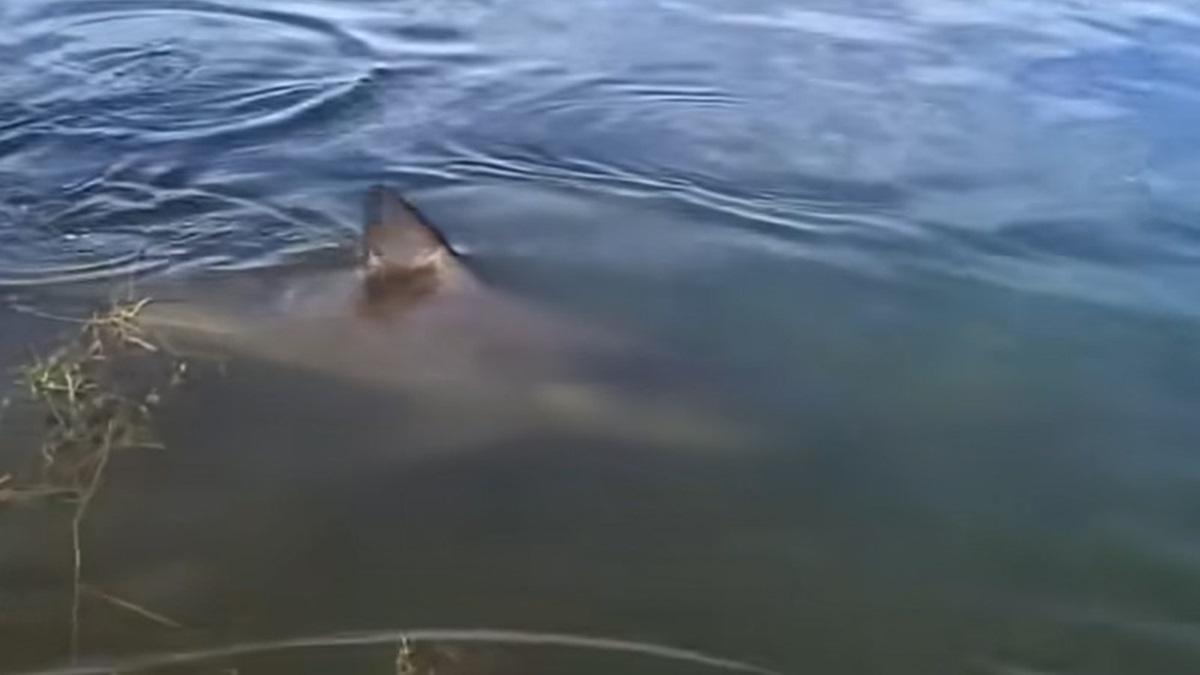
A bull shark in the Carbrook Golf Club lake. Pic credit: Scott Wagstaff/YouTube
In the late 1990s, multiple reports of mysterious shapes and movements inside a lake in the middle of a golf course in Australia sparked claims that a creature similar to the Scottish Loch Ness Monster lived there.
Eyewitness accounts and descriptions by golfers and staff at the Carbrook Golf Club, about 40 minutes drive from Brisbane, Queensland, suggested to monster enthusiasts that a creature similar to the Loch Ness Monster lived inside the water.
But others believed it was a monster shark.
The belief that the lake had a resident monster persisted for many years until shocking proof eventually emerged that it was home to a shiver of about 6 to 12 bull sharks (Carcharhinus leucas).
Scotland is not the only country with legendary lake monsters, such as the Loch Ness Monster and Morag.
The Nahuelito is a Nessie-like monster native to Nahuel Huapi Lake, near Bariloche city, in the Province of Río Negro, Patagonia, Argentina.
The Bear Lake Monster is allegedly native to the Bear Lake, straddling the Utah-Idaho border.
Mussie and Champ are monsters from Canadian folklore. Mussie is associated with the Muskrat Lake in Whitewater Region, near Cobden village, Renfrew County, Ontario.
Australia’s version of the Loch Ness Monster
Claims that the golf course lake had a monster in it gained traction following reports of strange movements and dark shapes suggestive of a massive creature.
The eyewitness accounts passed into folklore, and locals shared rumors that the water was home to a cryptid.
Descriptions of the alleged monster suggested to some that it was similar to the Scottish Loch Ness Monster. Witnesses said it was a massive creature with a hump-like structure that showed above the water when it swam close to the surface.
But others, inspired by stories about dorsal fins sticking above the water, dubbed the monster the Carbrook Shark.
Witness images offered proof in the early 2000s
In the early 2000s, a witness captured a photo showing fins above the water, suggesting sharks.
Scott Wagstaff, the general manager of the Carbrook Golf Club, told CNN he proved that the mysterious dark shapes and movements were due to a shiver of bull sharks by throwing meat inside.
The sharks came to the surface to feed, and he filmed them. He shared the video on YouTube. It went viral online with 2.3 million views (see video below).
The hump-like structures that earlier witnesses reported were, in fact, shark fins. Thus, in a sense, the myth of a resident monster proved true, but not in the way cryptid hunters expected.
How did the sharks reach the lake from the sea?
It remained to explain how sharks appeared in a lake in the middle of a golf course without connection to nearby rivers and the sea.
Investigations suggested the sharks arrived during massive flooding in the 1990s that caused the Logan and Albert Rivers to overflow their banks.
Flood waters swept them into the lake, and they became trapped there when the flooding resided.
The sharks continued living there in the late 1990s and grew to adult size.
Bull sharks bred in the Carbrook Golf Club lake
The population persisted in the lake, bred, and produced younger sharks.
Carbrook Golf Club reaped the benefits of international attention due to its reputation as the “most dangerous golf course in the world.”
Bull sharks (Carcharhinus leucas) are among the most aggressive of shark species. They are known for their tolerance of freshwater environments. They often enter rivers, where they may attack unwary humans.
The golf course management noticed that the number of sharks in the lake dropped sharply after a flood in 2013, suggesting some might have died or found their way back to the rivers and sea.